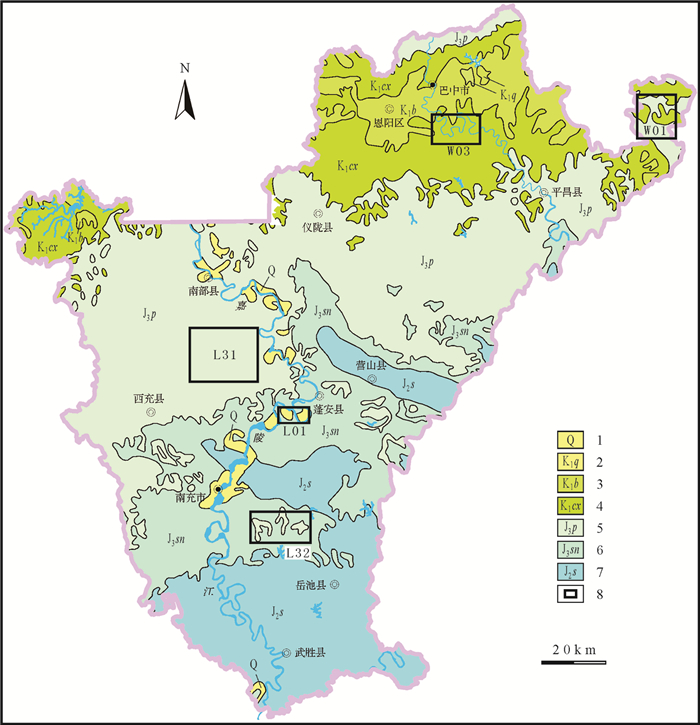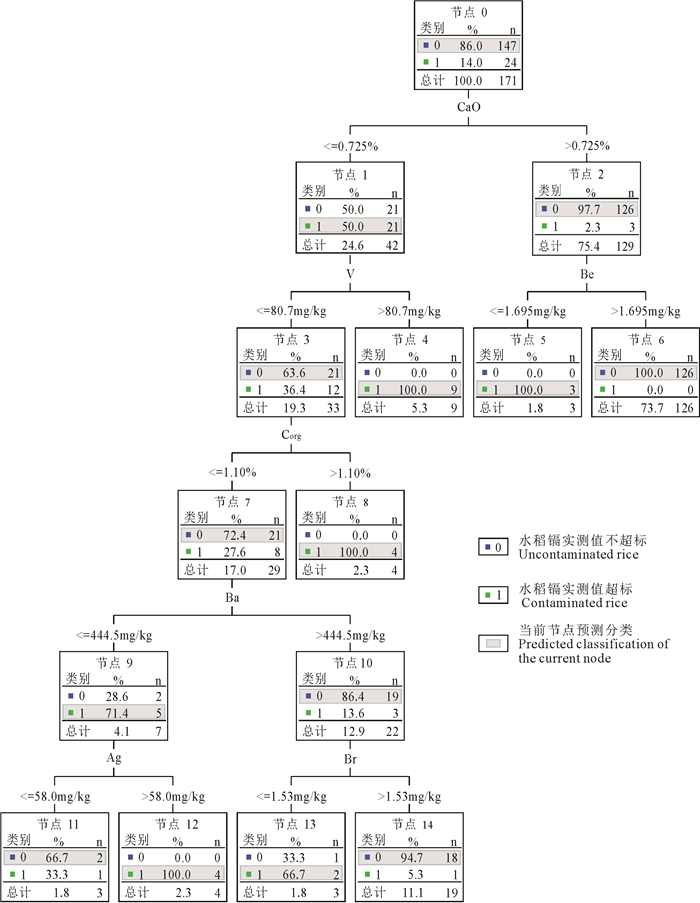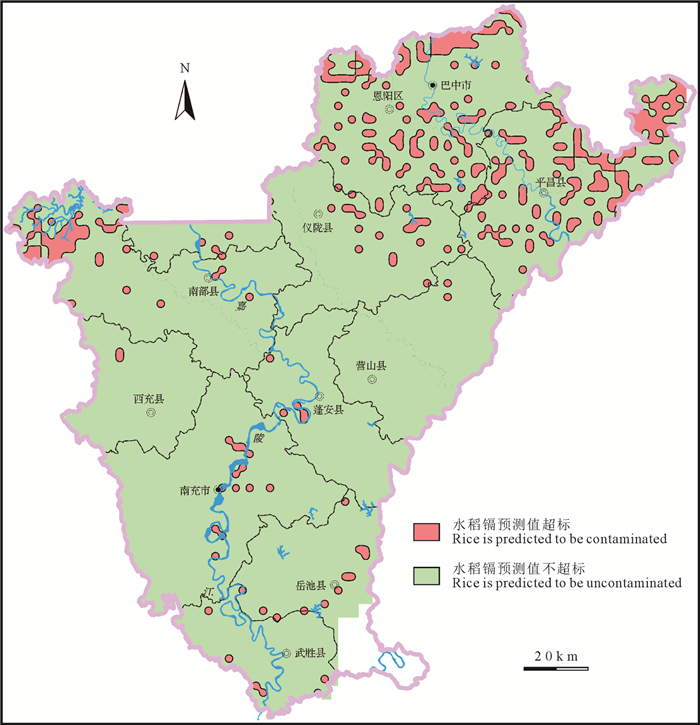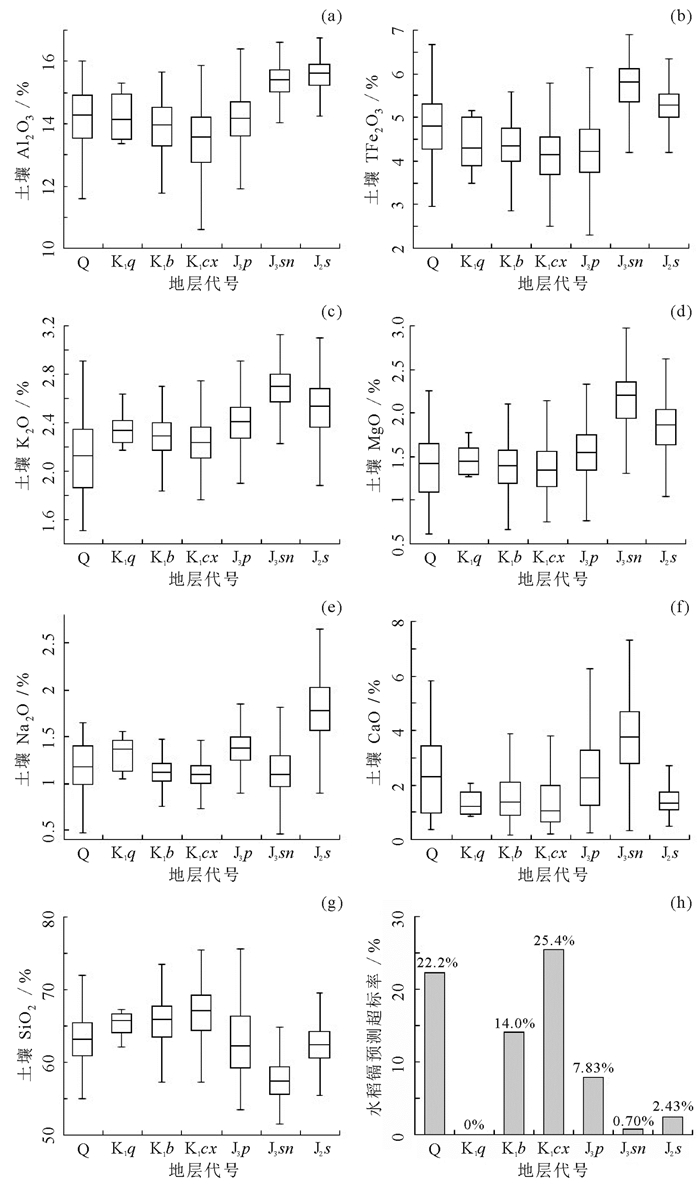Assessment of cadmium accumulation in rice and risk on human health in the northeast Sichuan Province
-
摘要:研究目的
重金属镉主要通过“土壤-植物”系统进入食物链进而影响人体健康,开展农作物镉积累研究对保障人类健康安全具有重要意义。
研究方法系统采集了四川省东北部南充市、巴中市、广安市等地的土壤及水稻样品,采用ICP-MS方法检测了土壤和水稻中的镉含量,并运用CART决策树和相关系数法进行了数据分析。
研究结果结果显示,川东北地区表层土壤镉含量相对较低,为0.071~0.92 mg/kg,平均0.254 mg/kg,几乎所有(99.9%)样品镉含量都低于标准限值;水稻(糙米)镉含量差异性较大,为0.002~0.803 mg/kg,平均0.076 mg/kg,超标率达14.0%;水稻镉超标区成人每日通过稻谷摄入的镉达90.4 μg/d,已超过允许摄入量标准60 μg/d。
结论土壤镉不超标而农作物镉超标的现象可能与土壤的低pH、低CaO、高SiO2等特点有关,这一认识对于指导区域内粮食安全生产具有重要指导意义。
创新点: 土壤和水稻综合调查发现土壤镉不超标但农作物超标的现象,CART和相关系数法分析了其原因。
Abstract:This paper is the result of agricultural geochemical survey engineering.
ObjectiveAs a heavy metal, cadmium (Cd) mainly enters the food chain through the "soil=plant" system and affects human health. It is great significant to study the accumulation of cadmium in crops to ensure human health and safety.
MethodsSoil and rice samples from Nanchong, Bazhong and Guang'an in the northeast Sichuan were collected. The cadmium content in soil and rice was analyzed by ICP=MS, and the data were statistically analyzed by CART decision tree and correlation coefficient methods.
ResultsThe research shows that the cadmium content of the soil in the northeast Sichuan is relatively low, ranging from the safety threshold. In contrast, the cadmium content of the rice (brown rice) varies from 0.002 to 0.803 mg/kg and with an average value of 0.076 mg/kg, 14.0% of which is above the safety threshold. The daily cadmium intake of adults reaches 90.4 μg/d in the region with excessive cadmium in rice, exceeding the permissible cadmium intake of 60 μg/d.
ConclusionsThe phenomenon that cadmium content does not exceed the safety threshold in soil but it does in rice may be related to the characteristics of low pH, low CaO and high SiO2 of the soil. This recognition is great significance for guiding grain production in this region. 0.071 to 0.92 mg/kg and with an average value of 0.254 mg/kg. The cadmium content of almost all (99.9%) soil samples is below
-
1. 引言
水系沉积物是岩石风化的产物,是上游汇水盆地物质的天然组合,在化学成分上与所流经汇水盆地内受剥蚀的地质体有明显的继承性和代表性(蒋敬业等,2006;郝立波等,2007;陆顺富等,2014)。利用这一特点,水系沉积物地球化学测量可以有效获取隐伏、半隐伏矿和难识别矿的成矿信息,为进一步开展地质勘查工作提供依据(夏祥标等,2009;李玉芹等,2011;宋贺民等2014;刘邦定等,2015),因而在金属矿产资源勘查中发挥着愈来愈重要的作用(杨伟寿等,2007;朱建华,2007;师淑娟等,2011;张江华等,2013;赵武强等,2014)。
完达山地区主要由一套近南北走向的玄武岩、堆晶岩、(超)基性熔岩、硅质岩和泥质岩组成(张兴洲,2010),是中国东部唯一的中生代海相地层发育区域(周建波等,2005;田东江,2007),出露有太平洋板块俯冲形成的增生杂岩组合(Kojima et al., 1987, 1989;Zheng, 1990;张世红等,1991;唐克东等,1995;张庆龙等,1997;田东江等,2006;张雪锋等,2014;王庆双等,2015;韦延兰等,2015),且中生代蛇绿岩发育,为中国典型的蛇绿岩发育地区之一(田东江,2007;Zhang et al., 2013)。研究区内矿产资源丰富,但受年均7~8个月的结冰期及森林植被覆盖影响,地质找矿勘查工作并不理想,在一定程度上制约了区域成矿规律的研究和资源评价工作的安排。有鉴于此,笔者从完达山1:20万水系沉积物测量数据入手,分析水系沉积物地球化学异常与地层、构造、岩浆岩及矿床之间的关系,阐明地球化学异常的控制因素,圈定有利的找矿靶区,为完达山地区整体找矿工作部署和区域成矿规律研究提供科学依据。
2. 成矿地质背景
完达山地区位于中国东北地区东部, 是完达山—锡霍特—阿林超地体在中国境内的出露部分, 西与南以宝清大和镇断裂和敦密断裂为界,东与北至乌苏里江边和小佳河镇胜利农场,东西宽约80 km,南北长约240 km,总体上呈近南北向略向西突出的弧形分布,并向宝清过渡带逆掩推覆。该区缺失太古宇、古生界的古老地层,而发育中生代和新生代地层(图 1)。
![]() 图 1 完达山地区区域地质图(据张国宾, 2014修改)Figure 1. Regional geological map of Wanddashan area (modified after Zhang, 2014)
图 1 完达山地区区域地质图(据张国宾, 2014修改)Figure 1. Regional geological map of Wanddashan area (modified after Zhang, 2014)区内构造较为发育,以北东向和北西向构造为主,主要包括敦化—密山断裂、大和镇断裂、富锦—小佳河断裂、饶河北西向断层束和饶河北北东向断层束。
区内岩浆岩十分发育,主要发育有晚古生代(超)基性岩、早中生代(超)基性岩和晚中生代酸性岩浆岩。晚古生代(超)基性岩分布于研究区西南部跃进山—曙光村—东方红一带,为跃进山蛇绿岩的重要组成部分,岩性为玄武岩、角闪辉长岩、辉长岩、蛇纹石化橄榄辉石岩等。早中生代(超)基性岩分布于研究区东部八里桥—仙人台一带,为饶河蛇绿岩的重要组成部分,岩性为玄武岩、枕状玄武岩、角闪辉长岩、单辉橄榄岩、堆晶辉长岩等。晚中生代酸性岩浆岩由酸性侵入岩和酸性火山岩组成,酸性侵入岩出露于蛤蚂河、蛤蟆通水库和东方红镇西北部,岩性为花岗闪长岩、正长花岗岩、斜长花岗岩和二长花岗岩等。酸性火山岩位于研究区南部大塔山林场组和皮克山组地层中,岩性为流纹岩、流纹质凝灰岩、流纹质凝灰熔岩、热液角砾岩等。
区内金属矿产主要与晚中生代晚期酸性岩浆岩和早中生代(超)基性岩有关,矿种为金、银、铜、镍、钴等,到目前为止,已发现中型矿床1座(四平山金矿床),小型矿床4座(先锋北金矿床、258高地金矿床、358高地金矿床、跃进山铜金属矿床),矿点10余处(蛤蟆河金矿点、宝丰村金矿、永幸铜镍矿点等)。
3. 地球化学特征
3.1 样品采集加工与分析质量
样品采集严格遵守1:20万水系沉积物测量规范,平均采样密度为1.18个/4 km2,采集样品2114件(不包括重复密码分析样)。采样点主要分布在二、三级水系内,长度为1~2 km的一级水系口,长度大于2 km的一级水系内适当增加采样点,采样介质为活性水系沉积物(如:淤泥、粉砂),每个样品在采样点附近30~50 m范围内进行多点(不少于3点)采集,合并为一个样品,样品重量过筛后不少于300 g,取10~60目粒度作为分析样品(杨小峰等,2007;李林山等,2009;朴寿成等,2009)。分析测试单位为国土资源部哈尔滨矿产资源监督检测中心,分析测试方法采用原子吸收分光光度法(AAS)、原子荧光分光光度法(AFS)、X射线荧光光谱法(XRF)和电感耦合等离子体质谱法(ICP-MS)等方法,样品分析项目为As、Au、Hg、Sb、Ag、Cu、Pb、Zn、Bi、Mo、Sn、W、Co、Cr、Ni、V。
根据森林沼泽区技术方法研究要求,在分析元素、测试分析配套方案、测试分析质量监控方法等方面制定了统一的技术方法。其中,测试分析质量监控采用外部质量监控和内部质量监控相结合的方法,实验室内部按样品总数随机抽取5%的重份样品进行分析,合格率为100%,同时随机抽取8%的样品进行随机重复密码分析,合格率为97%。综上所述,分析报告中的化探数据可靠,分析质量达到或优于规范质量等级。
3.2 元素含量特征
采用元素含量最高值(CMax)、最低值(CMin)、平均值(X)、标准离差(S)、变异系数(CV)、富集系数(K)等地球化学参数来阐明和讨论1:20万水系沉积物地球化学特征及规律。浓集系数(K)为研究区元素平均值与全省元素平均值之比,变异系数(CV)为元素标准偏差与均值之比。
研究区内Au、Cu、Pb、Zn、Sn、W、Co、Ni、V、Cr元素的浓集系数均大于1.00,表明这些元素在完达山地区具有一定的次生富集倾向,有利于成矿;Ag、Hg、Bi、Sn、Mo元素的浓集系数小于1.00(表 1),表明这些元素在完达山地区趋于贫化,成矿作用相对较弱。结合研究区各元素变异系数由Bi−Cr−Au−Ni−Hg−Ag−As−Sn−Sb−Cu−Co−Mo−W−Zn−V−Pb逐渐下降,意味着从Bi到Pb成矿作用依次减弱。
表 1 完达山地区水系沉积物地球化学特征参数Table 1. Geochemical parameters of the stream sediment samples from Wandashan area
3.3 元素变化特征
水系沉积物样品中各元素原始数据的变异系数(CV1)(薛水根,1979;刘劲松等,2016)和背景数据(采用>X+3S及<X−3S迭代剔除,直至无离群点数值可剔除为止,即所有数据全部分布>X-3S与<X+3S间)的变异系数(CV2)反映了数据处理前后的离散程度(张运强等,2015),CV1/CV2反映背景拟合处理时离散值的削平程度。因而可以利用CV1和CV1/CV2制作变异系数图解,从变异系数图解(图 2)中可以看出,区内Bi含量变化幅度最大,高强度数据最多,分布极不均匀,成矿特别有利;Au、Ni、Cr、Hg高强度数据较多,变异系数较大,有利于成矿,且大多数异常内已发现矿床(点)(如四平山金矿、先锋北山金矿、跃进山金矿、永幸铜镍矿点等);Ag、As、Sn、Sb、Cu、Co、Mo、W、Zn、V、Pb在测区中的CV1和CV1/CV2值都比较低,成矿可能性较低。
3.4 元素分布特征
通对完达山地区2114件水系沉积物样品的地球化学数据统计,得到各元素丰度直方图。由该元素丰度直方图(图 3)可知,Au、Bi、Ni、Cr元素的标准偏差分别为1.22、0.49、32.88、106.75,变异系数分别为1.05、1.42、0.99、1.21,呈非正态分布,具有较强的成矿潜力;Hg、Ag、Cu、Co元素的标准偏差分别为42.25、52.88、11.21、6.22,变异系数分别为0.99、0.58、0.44、0.40,呈近似正态分布,具有一定的成矿潜力;As、Sb、Pb、Zn、W、Mo、Sn、V元素的标准偏差分别为5.00、0.22、3.50、21.89、0.67、0.49、1.75、18.07,变异系数分别为0.53、0.47、0.15、0.25、0.35、0.40、0.53、0.23,服从正态分布,成矿潜力较弱。
3.5 元素相关性特征
3.5.1 聚类分析
由表 2可知,Co、Cr、Ni、Cu、Zn、V元素呈显著正相关,Au、As、Sb、Bi、Sn元素之间呈正强相关。在R聚类分析图中(图 4),以R= 0. 3为界成矿元素可分5类。
表 2 完达山地区水系沉积物成矿元素相关系数矩阵Table 2. Correlation coefficient matrix of metallogenic elements from Wandashan area
第一类Bi、Sn:主要分布于完达山西南部蛤蟆通岩体内,其次分布于大顶子—仙人台(超)基性岩带中,反映与高温热源作用相关的矿化信息。
第二类Au、Ag、Hg:异常分布与岩浆岩体相关,Au与Ag、Hg相关性较强,代表低温热液矿化作用,组合异常是测区寻找Au、Ag矿床的重要地球化学找矿标志。
第三类Co、Cr、Ni、Cu、Zn:位于大顶子—仙人台(超)基性岩带和跃进山—曙光村—东方红(超)基性岩带内,Co、Cr、Ni密切相关,反映Co、Cr、Ni、Cu、Zn元素富集与蛇绿岩中(超)基性岩形成相关。
第四类W、Mo:与Co、Cr、Ni、Cu、Zn和As、Sb、Pb、V均具有一定的相关性,其成因复杂,既受岩浆热液控制又受地层控制。
第五类As、Sb、Pb、V:元素具有一定相关性,其富集作用主要与三叠纪地层相关,为层控元素。
3.5.2 因子分析
样品原始数据因子分析的相关矩阵特征根和累积百分比见表 3,前6个特征根代表的方差占总方差的68.6%,因此视这前6个因子为主要因子。
表 3 完达山水系沉积物成矿元素主因子分析Table 3. Principal factor analysis of metallogenic elements from Wandashan area
F1因子贡献率最大,变量元素有Co、Cr、Ni、Cu、Zn、V,以亲铁元素为主,与区内蛇绿岩中的(超)基性岩体相关。F2因子的元素组合为Au、Bi、Sn,反映岩浆岩矿化作用,低温的Au元素可能与高温的Bi、Sn元素具有同源关系。F3因子的元素为Au、As、Sb,是本区最为重要的一种元素组合,与酸性岩浆岩相关,反映中低温热液矿化作用。
F4、F5因子的元素组合为W、Mo、Cu和Ag、Cu、Zn、Pb,分别代表研究区高温与中温矿化阶段。F6因子的变量元素仅有熔点较低Hg元素,Hg迁移能力非常强,暗示本区内多金属成矿作用与中酸性含矿热液沿构造充填作用有关。
4. 地球化学异常分析
4.1 单元素异常特征
文中异常外带边界、中带边界和内带边界分别由异常下限、2倍异常下限和4倍异常下限确定。异常下限计算公式为:Ct=X+2δ (X为背景平均值,δ为标准离差,Ct为异常下限)。
由图 5可知,完达山地区共圈出Au元素异常9处,Au−2、Au−3、Au−7、Au−8为多点内带异常,异常面积大、衬度高,具有较强的找矿意义,是重要的Au找矿靶区;Au−1、Au−4、Au−5、Au−6、Au−9为多点中带异常,为找矿远景区。Au−2异常位于哈蚂河岩体内,面积约为49.01 km2,呈闭合的不规则椭圆状,2个浓集中心,浓集中心最大值为16.83×10-9,258金矿床就位于该Au异常带内;Au−3异常位于四平山附近,面积约为49.13 km2,为闭合的不规则状,呈北东向展布,有1个浓集中心,浓集中心最大值为19.60×10-9,四平山金矿床处于该Au异常带内;Au−8异常位于蛤蟆通岩体内,面积约为59.15 km2,为闭合的不规则状,呈北东向展布,有2个浓集中心,浓集中心最大值为20.80×10-9。
As元素异常总体规模较小,无多点内带异常,5处多点中带异常。其中,As−3、As−5异常分别与Au −3、Au−9和Ag−5、Ag−7等元素异常完全套,表明As可作为寻找Au、Ag矿床(体)的指示元素。
Sb元素异常规模较小,无多点内带异常,4处多点中带异常。其中,Sb−2异常与Au−3和Ag−5套和较好,Sb−4异常与Au−9和Ag−7套和较好。
Hg元素异常3处,Hg−1为多点内带异常,异常面积大、衬度高,呈闭合的不规则状,面积约为50.01 km2,有1个浓集中心,浓集中心最大值为1600.00×10-9;Hg−2位于四平山金矿区附近,为多点中带异常,与Au−3和Ag−5套和较好,呈闭合的圆形,面积约为60.46 km2,有2个浓集中心,浓集中心最大值为160.00×10-9。Hg−3为多点中带异常,呈闭合的圆形,面积约为12.57 km2,有1个浓集中心,浓集中心最大值为206.00×10-9。
Ag元素异7处,Ag−2、Ag−6为多点内带异常,异常面积大、衬度高,具有重要找矿意义,可以作为Ag找矿靶区;Ag−1、Ag−3、Ag−4、Ag−5、Ag−7为多点中带异常,可以作为找矿远景区。Ag−2异常位于研究区北部,呈闭合的圆形,面积约为17.85 km2,有1个浓集中心,浓集中心最大值为1220.00×10-9,目前尚未发现Ag矿床(点),找矿潜力较大;Ag−6异常位于跃进山附近,呈闭合的圆形,面积约为20.00 km2,有1个浓集中心,浓集中心最大值为1610.00×10-9,跃进山铜金矿床位于该异常内;Ag−5异常位于四平山附近,面积约为35.43 km2,有1个浓集中心,浓集中心最大值为285.00×10-9,四平山金矿床位于该异常内;Ag−7异常位于先锋北山附近,面积约为61.27 km2,有1个浓集中心,浓集中心最大值为455.00×10-9,先锋北山金矿床位于该异常内。虽然,Ag−3、Ag−4异常内尚未发现相应的Ag矿床(点),但这两处异常带规模较大,异常衬度较高,找矿潜力较好。
Cu元素异常8处,Cu−7为多点内带异常,其他7处均为多点中带异常。Cu−1、Cu−2、Cu−3、Cu−4异常分布与八里桥—仙人台(超)基性岩带分布基本一致;Cu−5、Cu−6、Cu−7、Cu−8异常与跃进山—曙光村—东方红(超)基性岩带套合较好。
Pb、Zn异常主要分布于研究区东部和西南部,规模较小,无异常内带,形成铅、锌矿床的可能性较小,找矿潜力不大。
W元素异常3处,W−1位于矿区东部,为多点内带异常,面积约为204.35 km2,有2个浓集中心,浓集中心最大值为13.60×10-6,异常面积大、衬度高,异常内已发现小别拉坑钨锡矿点,具有一定的找矿前景,可以作为W的找矿靶区。
Mo元素异常3处,Mo−3位于研究区东部,为多点内带异常,衬度高,面积约为41.66 km2,有1个浓集中心,浓集中心最大值为13.75×10-6,具有较好的找矿潜力,可作为钼矿找矿靶区。
Sn元素异常3处,Sn−1位于蛤蟆岩体南部边缘,为多点中带异常,面积约为57.41 km2,有1个浓集中心,浓集中心最大值为9.00×10-6,主要受蛤蟆河岩体控制;Sn−2异常位于研究区东部(超)基性岩带内,为多点内带异常,面积约为32.79 km2,有1个浓集中心,浓集中心最大值为26.00×10-6;Sn−3异常位于蛤蟆通岩体内,为多点内带异常,面积约为94.01 km2,有5个浓集中心,浓集中心最大值为45.00×10-6。
Bi元素异常共5处,Bi−1、Bi−2位于大顶子—仙人台(超)基性岩带内,为多点中带异常,面积和浓集中心最大值分别为23.98 km2、26.31 km2和1.62×10−6、1.25×10-6;Bi−3、Bi−4位于研究区中部,为多点中带异常,面积和浓集中心最大值分别为20.13 km2、11.55 km2和1.60×10-6、6.20×10-6;Bi−5异常位于蛤蟆通岩体内,为多点内带异常,面积约为126.91 km2,有1个浓集中心,浓集中心最大值为12.59×10-6。
Co元素异常3处,Co−1异常位于大顶子—仙人台(超)基性岩带内,为多点内带异常,异常衬度高,面积约为396.13 km2,有6个浓集中心,浓集中心最大值为97.80×10-6,具有较好的找矿潜力,为钴矿找矿靶区。Co−2异常位于龙间山附近,面积约为9.13 km2,有1个浓集中心,浓集中心最大值为48.70×10-6;Co−3异常位于跃进山—曙光村—东方红(超)基性岩带内,为多点中带异常,衬度高,面积约为99.98 km2,有1个浓集中心,浓集中心最大值为78.20×10-6。
Ni元素异常5处,Ni−1异常位于大顶子—仙人台(超)基性岩带内,为多点内带异常,异常衬度高,面积约为335.86 km2,有4个浓集中心,浓集中心最大值为714.80×10-6,具有较好的找矿潜力,异常内已发现永幸铜镍矿点;Ni−4异常位于跃进山—曙光村—东方红(超)基性岩带内,为多点中带异常,面积约为102.19 km2,有3个浓集中心,浓集中心最大值为132.30×10-6;Ni−2、Ni−3、Ni−5异常为中异常,异常面积小,衬度低,找矿潜力不大。
Cr元素异常3处,Cr−1异常位于大顶子—仙人台(超)基性岩带内,呈近南北向分布,面积约为511.55 km2,有4个浓集中心,浓集中心最大值为1771.30×10-6,具有较好的找矿潜力;Cr−3异常位于跃进山—曙光村—东方红(超)基性岩带内,多点中带异常,面积约为218.55 km2,有4个浓集中心,浓集中心最大值为892.60×10-6。
V异常总体规模较小,较为分散,且无中带或内带异常,形成矿床的可能性较小,找矿潜力不大。
4.2 组合元素异常特征
在单元素异常的基础上,根据异常性质、组合特征以及异常所处的地质背景、成矿地质条件等因素共圈出6个组合异常(图 6)。其特征如下:
4.2.1 HS−1号组合异常
HS−1号组合异常仅有一个Au−2异常,考虑Au−2异常的重要性,特将它圈定为一个组合异常,强调其重要性。Au−2异常位于哈蚂河岩体内,出露岩性主要为花岗闪长岩,局部见有北东向闪长玢岩脉。Au−2为多点内带异常,呈闭合的不规则状,北东向展布,分布面积约为49.01 km2,2个浓集中心,浓集中心最大值为16.83×10-9,区内已发现258金矿床。
4.2.2 HS−2号组合异常
HS−2号组合异常规模大,强度高,为Cu−Cr−Ni −Co−Bi−Sn−Mo−W元素组合异常,与区内八里桥—仙人台(超)基性岩体带的分布位置基本一致,呈北北东向展布,面积为693.75 km2,长约为46 km,宽为7~26 km,主要以Cu、Ni、Cr、Co异常为主。Cu、Ni、Cr元素异常分布面积大,含量高,Cu异常具中带、外带,面积约为289.53 km2,浓集中心最大值为130.10×10-6;Ni异常具有内带、中等、外带,面积约为359.88 km2,浓集中心最大值为714.80×10-6;Cr异常具有内带、中等、外带,面积约为511.55 km2,有4个浓集中心,浓集中心最大值为1771.30×10-6。Cu、Cr、Ni、Co、Bi、Sn、Mo、W单元素异常套合性较好,浓集中心一致,结合区域地质特征可知,该组合异常与(超)基性岩带相关性较强,且组合异常内发现多处矿(化)点(如:永幸铜镍点、向阳铜矿点、小别拉坑钨锡矿点等),因此,该区域应该重点寻找与(超)基性岩相关的Cu、Ni、Cr等矿产资源。
4.2.3 HS−3号组合异常
HS−3号组合异常位于八里桥—仙人台(超)基性岩体带西侧的大岭桥组杂砂岩、泥粉质砂岩、砂质板岩和泥岩中,呈北北东向展布,面积为200.36 km2,长约为25 km,宽为3~12 km,主要以Ag异常为主。Ag异常具有中等、外带,面积约为85.20 km2,有2个浓集中心,浓集中心最大值为400.00×10-9。Ag、Bi、Sn、As等元素异常套合较好,浓集中心基本一致。受工作环境的影响,该组合异常区内尚未发现Ag、Bi、Sn矿床(点)。
4.2.4 HS−4号组合异常
HS−4号组合异常位于四平山—358高地一带,呈北东向展布,面积为141.26 km2,以Au异常为主,出露岩性为流纹岩、花岗岩、硅质岩、砂岩、杂砂岩和泥岩等。Au、Ag、Hg、Sn元素异常套合较好,浓集中心基本一致。Au异常由Au−3和Au−4异常组成,四平山金矿床和358金矿床分别位于Au−3和Au−4异常内。
4.2.5 HS−5号组合异常
HS−5号组合异常为Au−Hg−Sn−Bi−Ni−Cr−W元素组合异常,位于红旗屯—炮手营—东旺屯附近,出露岩性为中生代的硅质岩、砂岩、杂砂岩及泥岩,呈北西向展布,分布面积为181.03 km2,主要以Au异常为主。Au异常具有内带、中等、外带,面积约为32.83 km2,有2个浓集中心,浓集中心最大值为9.50×10-9。由于工作程度较低,该异常区尚未发现Au矿床(点),找矿潜力较大。
4.2.6 HS−6号组合异常
HS−6号组合异常规模大,强度高,为Au−Ag−Sb−As−Cu−Ni−Cr−Co−Bi−Pb−Zn元素组合异常,位于跃进山—曙光村—东方红一带,出露岩性为(超)基性岩和酸性侵入岩,呈北北东向展布,面积372.60 km2,主要以Au、Cu、Ni、Cr、Co异常为主。Au异常由Au−8和Au−9组成(Au−8和Au−9异常特征在单元素异常中已详细描述),受酸性侵入岩控制,具有较好的找矿潜力。Cu、Ni、Cr、Co元素主要受跃进山—曙光村—东方红(超)基性岩带控制,Cu异常为多点内带异常,面积约为370.63 km2,有3个浓集中心,浓集中心最大值为174.70×10-6,具有较好的找矿潜力;Cr异常为多点内带异常,面积约为218.55 km2,有4个浓集中心,浓集中心最大值为892.60×10-6,具有较好的找矿潜力;Ni异常面积约为102.19 km2,有3个浓集中心,浓集中心最大值为132.30×10-6,具有一定的找矿潜力。
5. 成矿远景区圈定与评价
根据成矿地质背景、控矿条件、区域地球化学异常、区域航磁异常、区域重力异常以及区内矿床(点)分布规律等特征,研究区内共圈定4处成矿远景区:258高地金、银成矿远景区(YJQ−1);八里桥—仙人台铜、镍、钨、锡成矿远景区(YJQ−2);四平山— 358高地金、银成矿远景区(YJQ−3);跃进山—先锋北山金、银、铜、铁成矿远景区(YJQ−4) (图 7)。
![]() 图 7 完达山地区成矿远景区划分图(据张国宾, 2014修改)Figure 7. Metallogenic prospective areas in Wandashan area (modified after Zhang, 2014)
图 7 完达山地区成矿远景区划分图(据张国宾, 2014修改)Figure 7. Metallogenic prospective areas in Wandashan area (modified after Zhang, 2014)5.1 258高地金成矿远景区
258高地成矿远景区位于完达山地区北部蛤蟆河岩体内,呈北东—南东向L形展布,长16~17 km,宽8~10 km,面积约220 km2。区内断裂构造发育,对成矿有利的侵入岩为早白垩世晚期酸性侵入岩体。1:20万水系沉积物化学异常以Au−2异常为主,Au−2异常面积较大,约为32.83 km2,具有异常内带、中等、外带和2个浓集中心。已知矿床(点)有258金矿床和蛤蟆河金矿化点。围岩蚀变强烈,主要有硅化、绢云母化、高岭土化、绿泥石化,主攻矿种为金,主攻矿床类型为浅成低温热液型金矿床。
5.2 八里桥—仙人台铜镍钨锡成矿远景区
该成矿远景区位于完达山地区东北部,呈北北东向长条状展布,长约41 km,宽约13 km,面积近500 km2。区内断裂构造以北北东向为主,北西向、北东向次之。出露地层为上三叠统—中三叠统大佳河组硅质岩夹泥岩、粉砂岩,与成矿关系密切的岩体为八里桥—仙人台(超)基性岩带。1:20万水系沉积物地球化学异常主要以Cu−2、Cu−4、Co−1、Ni−1、Cr−1、Sn−2、W−1异常为主,Cu、Co、Ni、Cr、W、Sn元素异常套和较好,面积较大,除Cu元素只有异常中等和外带外,其他元素均具有异常内带、中等、外带和多个浓集中心。区内已发现矿(化)点有向阳铜矿点、永幸铜镍矿点、小别拉坑钨锡矿点等。围岩蚀变较为发育,主要有硅化、绿泥石化、绿帘石化、碳酸盐化,主攻矿种为铜、钴、镍、铬、钨、锡等中高温元素和亲铁元素,主攻矿床类型为岩浆熔离型铜镍铬矿床和细脉侵染型铜钨锡矿床。
5.3 四平山—358高地金银成矿远景区
该成矿远景区位于完达山地区东部,呈北西向长条状展布,长约20 km,宽约10 km,面积约200 km2。区内以北北东向和北东向构造为主,北西向构造次之。出露地层为上三叠统—中三叠统大佳河组硅质岩夹泥岩、粉砂岩,上三叠统—下侏罗统大岭桥组粉砂岩、砂岩夹薄层硅质岩,下白垩统穆棱组砂岩、泥质粉砂岩,四平山组泉胶砾岩夹泉胶砂岩、硅质岩。与成矿相关的岩体主要为白垩系流纹岩、花岗斑岩和花岗闪长玢岩。1:20万水系沉积物地球化学异常主要以Au−3、Au−4、Ag−5异常为主,Au−3和Ag−5异常位于四平山矿区附近,套和较好。Au−3异常面积约为49.13 km2,具有异常内带、中等、外带,浓集中心最大值为19.60×10-9;Ag−5具有异常中等、外带。Au−4异常位于358金矿区附近,具有异常中等、外带,2个浓集中心。区内发现的矿床(点)有四平山金矿床、358高地金矿床。围岩蚀变强烈,主要有硅化、绢云母化、绿泥石化、绿帘石化、叶腊石化、碳酸盐化等,主攻矿种为金、银,主攻矿床类型为浅成低温热液型金、银矿床。
5.4 跃进山—先锋北山金银铜铁成矿远景区
该成矿远景区位于完达山地区西南部,呈南北向长条状展布,长约30 km,宽约12 km,面积近63 km2。区内以北西向和北东向构造为主,近东西向和近南北向构造次之。出露地层为上三叠统—中三叠统大佳河组硅质岩夹泥岩、粉砂岩,下白垩统穆棱组砂岩、泥质粉砂岩。金、银矿化主要与酸性侵入岩体(蛤蟆通岩体、尖山子岩体以及后期侵入的酸性岩株、岩脉)相关,铜、铁、镍矿化主要与跃进山—曙光村—东方红(超)基性岩带相关。1:20万水系沉积物地球化学异常主要以Au−8、Ag−6、Ag−7、Cr −3、Cu−6、Cu−7、Cu−8、Ni−4、Sn−3异常为主。其中,Au、Ag异常分布于酸性侵入岩中及其附近,与酸性侵入岩体套和较好。Au−8异常面积约为59.15 km2,具有异常内带、中等、外带,2个浓集中心,浓集中心最大值为20.80×10-9;Ag−7异常面积约为61.27 km2,具有异常中等、外带,浓集中心最大值为455.00×10-9。Cu、Ni、Sn等单元素异常位于(超)基性岩带内及其附近。Cu−7异常面积约为17.75 km2,具有异常中等、外带,浓集中心最大值为174.70×10-6;Cu−8异常面积约为103.66 km2,具有异常中等、外带和3个浓集中心,浓集中心最大值为109.90×10-6。Ni−4异常和Sn−3异常主要位于(超)基性岩带内,异常面积大,Ni−4、Sn−3异常与(超)基性岩体套和较好,具有异常中等、外带和多个浓集中心。区内已发现的矿床(点)有先锋北山金矿床、跃进山铁矿床、跃进山铜金矿床、曙光村铜矿点等。围岩蚀变较为发育,且分带性明显,主要有硅化、绿泥石化、绢云母化、碳酸盐化、叶腊石化,主攻矿种为金、银、铜、镍、铬、锡等,主攻矿床类型为浅成低温热液型金银矿床、火山热液型金银矿床和熔离型铜镍铬矿床。
6. 结论
(1) 研究区内Au、Ni、Cr、Bi、Hg异常高值点多、变异系数值高、离散性强,地质及地球化学条件优越,成矿潜力强。
(2) Au、Ag、Hg、As、Sb异常规模较大、套合好,多富集于中酸性岩浆岩体内及其附近,与低温热液型成矿作用相关;Cr、Ni、Co、V、Cu、Zn异常套合较好,主要分布于大顶子—仙人台(超)基性岩带和跃进山—曙光村—东方红(超)基性岩带内,与高温岩浆熔离型成矿作用相关。
(3) 完达山地区共优选出4处成矿远景区,分别为258高地金成矿远景区、八里桥—仙人台铜镍钨锡成矿远景区、四平山—358高地金银成矿远景区和跃进山—先锋北山金银铜铁成矿远景区。
-
图 1 研究区地质简图
1—第四系;2—下白垩系统七曲寺组;3—白龙组;4—苍溪组;5—上侏罗统蓬莱镇组;6—遂宁组;7—中侏罗统沙溪庙组;8—水稻样品采样区:W01—平昌县界牌—笔山;W03—巴州区梁永—金碑;L01—蓬安县三坝—马回;L31—南部县铁佛塘—八尔湖;L32—岳池县黄龙及邻区
Figure 1. Geological sketch map of the study area
1-Quaternary; 2-Qiqusi Formation of Lower Cretaceous; 3 -Bailong Formation; 4 -Cangxi Formation; 5-Penglaizhen Formation of Upper Jurassic; 6-Suining Formation; 7-Shaximiao Formation of Middle Jurassic; 8-Rice sampling area: W01-Jiepai-Bishan, Pingchang; W03-Liangyong-Jinbei, Bazhou; L01-Sanba -Mashui, Peng'an; L31-Tiefutang-Ba'erhu, Nanbu; L32-Huanglong, Yuechi, and its adjacent areas
表 1 研究区土壤镉统计参数(mg/kg)
Table 1 Statistical parameters of soil cadmium in study area (mg/kg)

表 2 典型区水稻镉含量特征(mg/kg)
Table 2 Statistical parameters of rice cadmium in typical area (mg/kg)

表 3 模型区CART分类结果
Table 3 CART classification results in model area

表 4 水稻镉与土壤重要微量元素和氧化物的相关关系
Table 4 Correlation between cadmium in rice and important micro elements and oxides in soil

表 5 研究区镉摄入量估算
Table 5 Estimation of daily cadmium intake in study area

-
Alloway B J. 2013. Bioavailability of elements in soil[C]//Selinus O, Essentials of Medical Geology (2nd ed. ). Springer, Dordrecht, Netherlands, 351-373.
Asami T. 1984. Pollution of soils by cadmium[C]//Nriagu J O. Changing Metal Cycle and Human Health, Springer Verlag, Berlin, Germany, 95-111.
Chen Deyou, Jin Lixin, Li Zhonghui. 2006. Report on Multi-objective Regional Geochemical Survey of Chengdu Economic Zone[R]. Chengdu: Sichuan Geological Survey Institute (in Chinese).
Cheng Hangxin, Peng Min, Han Wei. 2019. Report on the Second Level Project of 1: 250000 Land Quality Geochemical Survey in the High Background Area of Heavy Metals in Southwest China[R]. Langfang: Institute of Geophysical and Geochemical Exploration, Chinese Academy of Geosciences, 103 (in Chinese).
Cheng Hangxin, Yang Xiaobo, Li Kuo, Liu Fei, Yang Ke, Nie Haifeng, Peng Min, Zhao Chuandong, Liu Yinghan. 2012. Geochemical early warning for soil acidification and its adverse biological effect of Cd in rice and maize seeds in the catchment area of Liaohe, Liaoning Province[J]. Journal of Jilin University (Earth Science Edition), 42 (6): 1889-1895 (in Chinese with English abstract).
Cheng Jinjin, Song Jing, Chen Wenchao, Yu Haibo, Huang Yujuan, Wu Longfa, Luo Yongming. 2013. The ecotoxicity effects of cadmium on microorganism in udic-ferrosols and aquic-cambosols[J]. Asian Journal of Ecotoxicology, 8(4): 577-586 (in Chinese with English abstract).
China Environmental Monitoring Station. 1990. Background Values of Soil Elements in China[M]. Beijing: China Environmental Science Press, 28-87 (in Chinese).
Fan Pu, Luo Binjie, Huang Ruchang, Shen Ping, Hui RongYao, Shao Hongshun, Wang Youxiao, Rong Guanghua. 1980. Formation and migration of continental oil and gas in China (Ⅰ)[J]. Science in China, 4: 357-362 (in Chinese).
Fergusson J E. 1990. The Heavy Elements: Chemistry, Environmental Impact and Health Effects[M]. Oxford, UK.
Friberg L, Piscator M, Nordberg G F, Kjellström T. 1974. Cadmium in the Environment (2nd ed. )[M]. CRC Press, Boca Raton, Florida, USA.
Jin Lixin, Hou Qingye, Bao Yuhan, Xu Zhou, Li Zhonghui, Yang Zhongfang, Chen Deyou. 2008. Ecolocical security and residents health risk assessment on polluted farmaland by cadmium in Deyang Region[J]. Geoscience, 22 (6): 984-989 (in Chinese with English abstract).
Kabata-pendias A, Pendias H. 1984. Trace Elements in Soils and Plants[M]. CRC Press, Boca Raton, Florida, USA.
Khaliq M A, James B, Chen Y H, Saqib H S A, Li H H, Jayasuriya P, Guo W. 2019. Uptake, translocation, and accumulation of Cd and its interaction with mineral nutrients (Fe, Zn, Ni, Ca, Mg) in upland rice[J]. Chemosphere, 215: 916-924. doi: 10.1016/j.chemosphere.2018.10.077
Li F, Fu B, Wang X. 2004. Cadmium and zinc transfer from soil to plant: Potential use of two mathematical models[J]. Journal of Liaoning University, 31(3): 193-198.
Li Zhibo, Luo Yongming, Song Jing, Wu Longfa, Zhao Qiguo. 2008. Critical values for Cd in paddy field based on Cd risk of rice consumption: A case study[J]. Acta Pedologica Sinica, 45 (1): 76-81 (in Chinese with English abstract).
Pan Yang, Zhao Yujie, Zhou Qiwen, Liu Xiaowei, Zhang Tieliang, Xu Yaping, Li Ye, Lu Wenkui. 2015. InfIuence of soil pH on cadmium absorption by rice in main rice production region of South China[J]. Journal of Anhui Agricultural Science, 43 (16): 235-238 (in Chinese with English abstract).
Römkens P, Brus D J, Guo H Y, Chu C L, Chiang C M, Koopmans G F. 2011. Impact of model uncertainty on soil quality standards for cadmium in rice paddy fields[J]. Science of the Total Environment, 409: 3098-3105. doi: 10.1016/j.scitotenv.2011.04.045
Tang Doudou, Yuan Xuyin, Wang Yimin, Ji Junfeng, Wen Yubo, Zhao Wanfu. 2018. Enrichment characteristics and risk prediction of heavy metals for rice grains growing in paddy soils with a high geological background[J]. Journal of Agro-environment Science, 37(1): 18-26 (in Chinese with English abstract).
Tang Shijia, Sun Dejiang, Luo Youfang, Zhou Dahai. 1984. The fertility of purple soil in relation to the characteristics of plarent material in Sichuan Basin[J]. Acta Pedologica Sinca, 21 (2): 123-133 (in Chinese with English abstract).
Wang Keyue, Jin Tai, Liu Qizhan, Hua Haogen, Fang Yaoming, Zhou Xilei. 1994. Toxic effect of cadmium on kidney[J]. Chinese Journal of Industrial Hygiene and Occupational Diseases, 12 (3): 24-26 (in Chinese).
Wang X, Li X, Ma R, Li Y, Wang W, Huang H, Xu C, An Y. 2018. Quadratic discriminant analysis model for assessing the risk of cadmium pollution for paddy fields in a county in China[J]. Environmental Pollution, 236: 366-372. doi: 10.1016/j.envpol.2018.01.088
Wang Yating, Dang Yuan, Du Yanling, Yu Jiang, He Yuting, Shen Jie, Deng Siwei, Tao Hongqun. 2020. Availability and main driving mechanism of heavy metal cadmium in typical paddy soils in Chengdu Plain[J]. Jiangsu Agricultural Science, 48 (1): 225-231 (in Chinese).
Wang Yonghua. 2019. Geochemical Atlas of Southwest China[M]. Wuhan: China University of Geosciences Press: 92-93 (in Chinese).
Wang Yonghua, Liu Caize, Zeng Qinqin. 2019. Report on 1: 250000 Geochemical Survey of Land Quality in Chengdu-Chongqing Area[R]. Chengdu: Chengdu Center, China Geological Survey, 165 (in Chinese).
Wang Yuanmin, Chen Dongxiang, Tong Gguijie, Yuan Daohao, Li Fufu, Wu Shaohua. 2019. Spatial recognition and prediction of rice Cd over-standard based on decision tree model[J]. Journal of Ecology and Rural Environment, 15(11): 1475-1483 (in Chinese with English abstract).
Wu Qitang, A Morel J L, Guchert A. 1994. A mechanistic mathematical model for prediction the uptake of heavy metals by plants[J]. Acta Pedologica Sinica, 31 (1): 68-76 (in Chinese with English abstract).
Xiong Jie, Zhu Qihong, Huang Daoyou, Zhu Hanhua, Xu Chao, Wang Shai, Wang Hui. 2019. Prediction model for the accumulation of cadmium in rice in typical paddy fields of south China[J]. Journal of Agro-environment Science, 38 (1): 22-28 (in Chinese with English abstract).
Xu Hongning, Yang Jurong, Xu Jialin. 1995. Cd uptake by crops and root cation exchange capacity[J]. Agro-Environmental Protection, 14 (4): 150-153 (in Chinese).
Yan Ling, Liu Ming, Liu Mengmeng, Xu Yi. 2018. Trend on dietary structure among residents in Sichuan Province from 2002 to 2012[J]. Journal of Hygiene Research, 47 (5): 716-720 (in Chinese with English abstract).
Yang J, Zhao C, Yang J, Wang J, Li Z, Wan X, Guo G, Lei M, Chen T. 2020. Discriminative algorithm approach to forecast Cd threshold exceedance probability for rice grain based on soil characteristics[J]. Environmental Pollution 261: 1-12.
Yin Fuguang, Sun Jie, Ren Fei, Sun Zhiming, Wang Fangguo. 2016. Regional Geology of Southwest China[M]. Wuhan: China University of Geoscience Press, 21-39 (in Chinese).
Yu Tao, Yang Zhongfang, Zhong Jian, Cheng Xinbing. 2008. Factors affecting the geochemical behavior of heavy metal elements Pb and Cd in soil[J]. Earth Science Frontiers, 15(5): 067-073 (in Chinese with English abstract).
Zhang X, Lin F, Jiang Y, Wang K, Wong M T F. 2008. Assessing soil Cu content and anthropogenic influences using decision tree analysis[J]. Environmental Pollution, 156 (3): 1260-1267. doi: 10.1016/j.envpol.2008.03.009
Zhang Jian, Hu Shihua, Qin Yulong, Hu Chaoyun, Liu Xiaohu, Yu Rulong, Wang Kangming, Lou Kangfa. 2015. Geological Structure and Mineralization in Sichuan Province[M]. Beijing: Science Press, 1-244 (in Chinese).
Zhao Boyang. 1983. Current situation of cadmium toxicology research in Japan[J]. Chinese Journal of Industrial Hygiene and Occupational Diseases, (4): 242-244 (in Chinese).
Zhao K, Zhang W, Zhou L, Liu X, Xu J, Huang P. 2009. Modeling transfer of heavy metals in soil-rice system and their risk assessment in paddy fields[J]. Environmental Earth Sciences, 59 (3): 519-527. doi: 10.1007/s12665-009-0049-x
Zhou Yong, Li Xianghui, Sun Yong. 2011. Sedimentary facies and its paleoclimate significance for the upper Jurassic Penglaizhen Formation in Mingzhu Town, Shehong, Sichuan[J]. Acta Geologica Sichuan, 31 (2): 18-20 (in Chinese with English abstract).
Zhou Z, Chen Z, Pan H, Sun B, Zeng D, He L, Yang R, Zhou G. 2018. Cadmium contamination in soils and crops in four mining areas, China[J]. Journal of Geochemical Exploration, 192: 72-84. doi: 10.1016/j.gexplo.2018.06.003
陈德友, 金立新, 李忠惠. 2006. 成都经济区多目标区域地球化学调查报告[R]. 成都: 四川省地质调查院. 成杭新, 彭敏, 韩伟. 2019. 西南重金属高背景区1: 25万土地质量地球化学调查二级项目成果报告[R]. 廊坊: 中国地质科学院地球物理地球化学勘查研究所, 103. 成杭新, 杨晓波, 李括, 刘飞, 杨柯, 聂海峰, 彭敏, 赵传冬, 刘英汉. 2012. 辽河流域土壤酸化与作物籽实镉生物效应的地球化学预警[J]. 吉林大学学报(地球科学版), 42 (6): 1889-1895. https://www.cnki.com.cn/Article/CJFDTOTAL-CCDZ201206036.htm 程金金, 宋静, 陈文超, 余海波, 黄玉娟, 吴龙华, 骆永明. 2013. 镉污染对红壤和潮土微生物的生态毒理效应[J]. 生态毒理学报, 8 (4): 577-586. https://www.cnki.com.cn/Article/CJFDTOTAL-STDL201304026.htm 范璞, 罗斌杰, 黄汝昌, 沈平, 惠荣耀, 邵宏舜, 王有孝, 荣光华. 1980. 中国陆相油气的形成与运移(Ⅰ)[J]. 中国科学, 4: 357-362. https://www.cnki.com.cn/Article/CJFDTOTAL-JAXK198004005.htm 金立新, 侯青叶, 包雨函, 徐洲, 李忠惠, 杨忠芳, 陈德友. 2008. 德阳镉污染农田区生态安全性及居民健康风险评价[J]. 现代地质, 22 (6): 984-989. doi: 10.3969/j.issn.1000-8527.2008.06.014 李志博, 骆永明, 宋静, 吴龙华, 赵其国. 2008. 基于稻米摄入风险的稻田土壤镉临界值研究: 个案研究[J]. 土壤学报, 45 (1): 76-81. doi: 10.3321/j.issn:0564-3929.2008.01.010 潘杨, 赵玉杰, 周其文, 刘潇威, 张铁亮, 徐亚平, 李野, 吕文魁. 2015. 南方稻区土壤pH变化对稻米吸收镉的影响[J]. 安徽农业科学, 43 (16): 235-238. https://www.cnki.com.cn/Article/CJFDTOTAL-AHNY201516081.htm 唐豆豆, 袁旭音, 汪宜敏, 季峻峰, 文宇博, 赵万伏. 2018. 地质高背景农田土壤中水稻对重金属的富集特征及风险预测[J]. 农业环境科学学报, 37 (1): 18-26. https://www.cnki.com.cn/Article/CJFDTOTAL-NHBH201801003.htm 唐时嘉, 孙德江, 罗有芳, 周大海. 1984. 四川盆地紫色土肥力与母质特性的关系[J]. 土壤学报, 21 (2): 123-133. https://www.cnki.com.cn/Article/CJFDTOTAL-TRXB198402001.htm 王克跃, 金泰, 刘起展, 华浩根, 方耀明, 周希雷. 1994. 镉对肾脏的毒作用[J]. 中华劳动卫生职业病杂志, 12 (3): 24-26. https://www.cnki.com.cn/Article/CJFDTOTAL-ZHLD403.010.htm 王亚婷, 党媛, 杜焰玲, 余江, 何玉亭, 沈杰, 邓思维, 陶红群. 2020. 成都平原典型稻作土壤重金属镉有效性及主要驱动机制[J]. 江苏农业科学, 48 (1): 225-231. https://www.cnki.com.cn/Article/CJFDTOTAL-JSNY202001042.htm 王永华. 2019. 中国西南地区地球化学图集[M]. 武汉: 中国地质大学出版社: 92-93. 王永华, 刘才泽, 曾琴琴, 2019. 成渝地区1: 25万土地质量地球化学调查成果报告[R]. 成都: 中国地质调查局成都地质调查中心, 165. 王院民, 陈东湘, 仝桂杰, 颜道浩, 李富富, 吴绍华. 2019. 基于决策树模型的水稻镉超标空间识别及预测研究[J]. 生态与农村环境学报, 35 (11): 1475-1483. https://www.cnki.com.cn/Article/CJFDTOTAL-NCST201911017.htm 吴启堂, Morel J L, Guchert A. 1994. 一个定量植物吸收土壤重金属的原理模型[J]. 土壤学报, 31 (1): 68-76. doi: 10.3321/j.issn:0564-3929.1994.01.009 熊婕, 朱奇宏, 黄道友, 朱捍华, 许超, 王帅, 王辉. 2019. 南方典型稻区稻米镉累积量的预测模型研究[J]. 农业环境科学学报, 38 (1): 28-34. https://www.cnki.com.cn/Article/CJFDTOTAL-NHBH201901005.htm 徐红宁, 杨居荣, 许嘉琳. 1995. 作物对Cd的吸收与根系阳离子交换容量[J]. 农业环境保护, 14 (4): 150-153. https://www.cnki.com.cn/Article/CJFDTOTAL-NHBH504.001.htm 颜玲, 刘敏, 刘蒙蒙, 许毅. 2018. 2002-2012年四川省居民膳食结构变化[J]. 卫生研究, 47 (5): 716-720. https://www.cnki.com.cn/Article/CJFDTOTAL-WSYJ201805007.htm 尹福光, 孙洁, 任飞, 孙志明, 王方国. 2016. 中国西南区域地质[M]. 武汉: 中国地质大学出版社, 21-39. 余涛, 杨忠芳, 钟坚, 程新彬. 2008. 土壤中重金属元素Pb、Cd地球化学行为影响因素研究[J]. 地学前缘, 15 (5): 67-73. doi: 10.3321/j.issn:1005-2321.2008.05.007 张建东, 胡世华, 秦宇龙, 胡朝云, 刘啸虎, 俞如龙, 王康明, 娄康发. 2015. 四川省地质构造与成矿[M]. 北京: 科学出版社, 1-244. 赵伯阳. 1983. 日本镉毒理研究现况[J]. 中华劳动卫生职业病杂志, (4): 242-244. https://www.cnki.com.cn/Article/CJFDTOTAL-ZHLD198304015.htm 中国环境监测总站. 1990. 中国土壤元素背景值[M]. 北京: 中国环境科学出版社, 28-87. 周勇, 李祥辉, 孙勇. 2011. 四川射洪县明星镇上侏罗统蓬莱镇组岩相及古气候意义[J]. 四川地质学报, 31 (2): 18-20. https://www.cnki.com.cn/Article/CJFDTOTAL-SCDB201102004.htm




 下载:
下载:










